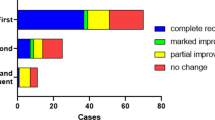Abstract
The aim of this study is to analyze the clinical characteristics and treatment of sudden sensorineural hearing loss (SSNHL) patients with vestibular schwannoma (VS). The clinical features of the VS patients were explored by retrospectively analyzing the clinical data from 542 cases of SSNHL patients between January 2008 and March 2013. There were 10 cases (10 ears) diagnosed with VS in 542 cases of SSNHL patients (10 ears, 1.85 %), 3 males, 7 females, with a range of 28–57 years. Among all the cases, eight patients with abnormal ABR, ten with ear ipsilateral stapedius reflexes which were completely not elicited and seven patients with healthy ear contralateral stapedius reflexes which were completely not elicited. Neuromas were classified by Koos grades according to size (8 of grade I, 1 of grade II, 1 of grade IV). Eight small VS patients were taken waiting and MRI therapy strategies. Meanwhile, we used glucocorticoid treatment and timely and short-term medication to improve the microcirculation of the inner ear for these patients. And four cases’ hearing was improved. Some vestibular schwannomas have SSNHL as initial symptoms, especially the small ones in internal auditory canal. To prevent misdiagnosis or leak-diagnosis, MRI should be performed as a routine test for SSNHL, and ABR is sometimes necessary for SSNHL patients. It is also necessary to give appropriate treatment to protect hearing of the small vestibular schwannoma patients whose first symptoms are diagnosed as SSNHL in acute phase.
Similar content being viewed by others
References
Editorial board of Chinese Journal of Otorhinolaryngology Head and neck surgery, Chinese Medical Association of Otorhinolaryngology, Head and Neck Surgery (2006) Guidelines for the diagnosis and treatment of sensorineural hearing loss (2005, **an). Chin J Otorhinolaryngol Head Neck Surg 41(8):325
Roth TN, Hanebuth D, Probst R (2011) Prevalence of age-related hearing loss in Europe: a review. Eur Arch Otorhinolaryngol 268(8):1101–1107
Ganzer U (2004) Leitlinie “Horsturz”. Konsensusbericht im Auftrag des Präsidiums der Deutschen Gesellschaft für Hals-Nasen-Ohren-Heilkunde, Kopf-und Hals-Chirurgie. HNO Inf 4:302–308
Koos WT (1985) Color atlas of microneurosurgery. Thieme-Stratton, New York, pp 188–212
Teranishi M, Katayama N, Uchida Y et al (2007) Thirty-year trends in sudden deafness from four nationwide epidemiological surveys in Japan. Acta Otolaryngol 127(12):1259–1265
Hallberg OE (1956) Sudden deafness of obscure origin. Laryngoscope 66(10):1237–1267
Miller C, Igarashi S, Jacob A (2012) Molecular pathogenesis of vestibular schwannomas: insights for the development of novel medical therapies. Otolaryngol Pol 66(2):84–95
Shaia FT, Sheehy JL (1976) Sudden sensori-neural hearing impairment: a report of 1,220 cases. Laryngoscope 86(3):389–398
Lee JD, Lee BD, Hwang SC (2011) Vestibular schwannoma in patients with sudden sensorineural hearing loss. Skull Base 21(2):75–78
Yanagihara N, Asai M (1993) Sudden hearing loss induced by acoustic neuroma: significance of small tumors. Laryngoscope 103(3):308–311
del Río L, Lassaletta L, Alfonso C et al (2006) Clinical tumoral size dissociation in acoustic neuroma: reality or measure distortion? Acta Otorhinolaryngol Esp 57(8):345–349
Press GA, Hesselink JR (1988) MR imaging of cerebellopontine angle and internal auditory canal lesions at 1.5 T. AJR Am J Roentgenol 150(6):1371–1381
Nascentes SM, Paulo EA, de Andrade EC et al (2007) Sudden deafness as a presenting symptom of acoustic neuroma: case report. Braz J Otorhinolaryngol 73(5):713–716
Aronzon A, Ruckenstein MJ, Bigelow DC (2003) The efficacy of corticosteroids in restoring hearing in patients undergoing conservative management of acoustic neuromas. Otol Neurotol 24(3):465–468
Conflict of interest
All the authors do not have a financial relationship with any organizations that sponsored the research.
Author information
Authors and Affiliations
Corresponding author
Additional information
Q. Gong and W. Zuo are joint first authors and these authors contributed equally to this study.
Rights and permissions
About this article
Cite this article
Lin, C., Gong, Q., Zuo, W. et al. The clinical characteristics and treatment for sudden sensorineural hearing loss with vestibular schwannoma. Eur Arch Otorhinolaryngol 272, 839–842 (2015). https://doi.org/10.1007/s00405-014-2885-x
Received:
Accepted:
Published:
Issue Date:
DOI: https://doi.org/10.1007/s00405-014-2885-x




